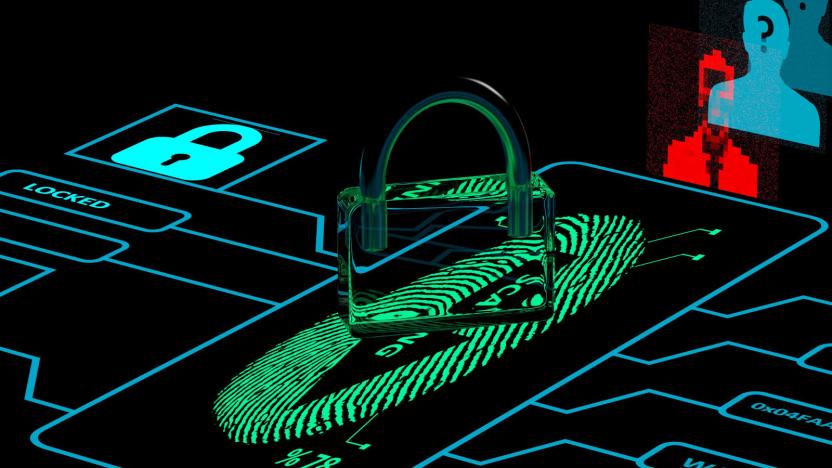MichiganStateUniversity
Latest

Facial recognition may help save endangered primates
Facial recognition isn't limited to humans. Researchers have developed a face detection system, PrimNet, that should help save endangered primates by tracking them in a non-invasive way. The neural network-based approach lets field workers keep tabs on chimpanzees, golden monkeys and lemurs just by snapping a photo of them with an Android app -- it'll either produce an exact match or turn up five close candidates. That's much gentler than tracking devices, which can stress or even hurt animals.

Roller coasters might help you pass a kidney stone
According to an new study from Michigan State University's College of Osteopathic Medicine, roller coasters can, in fact, do more than just give you a temporary thrill. Specifically, study author David Wartinger and his co-author Marc Mitchell set out to test the experience of one patient who claimed to have passed three kidney stones after taking three rides on Disney's Big Thunder Mountain Railroad.

Police get dead man's finger 3D-printed to unlock his phone
Michigan State University professor Anil Jain's work focuses on how to make biometric signifiers like facial recognition as difficult to hack into as possible. But when police approached him to break into someone's phone, they didn't want backdoor access around security measures — they wanted him to 3D-print a dead man's finger to get into his smartphone.

Switching to electric cars would help cool down cities
Electric cars can do more for the environment than cut back on air pollution and fossil fuel use -- they can make sweltering summers more bearable, too. Researchers have determined that EVs create a cooling effect in urban areas, since they aren't producing heat that builds up in traffic jams. That, in turn, reduces the need for air conditioning, which spews out pollution and chews up additional energy. In Beijing, a wholesale switch to electric cars in summer 2012 would have cooled things down enough to eliminate 11,779 tons of air conditioning-related carbon dioxide emissions per day, and 14.4kW of matching electricity use.

Online dating leads to more break-ups than meeting in real life
Online dating has reached the point where it isn't weird to say you met someone via the internet anymore. Tinder is another story, but that's a digression for a different day. However, while sites like eHarmony and Match are quick to espouse their success rates (the former claims that 438 members marry every day) it turns out their data, much like OKCupid, might not be telling the whole truth. A recent joint-study (PDF) conducted by Michigan State University and Stanford found that people who met online weren't as likely to stay together for the long haul as their offline-matched counterparts. The separation and divorce rates for folks who'd paired up online was much higher than their offline compatriots, and more online-founded relationships tended to end within a year after the survey. Is Online Better Than Offline For Meeting Partners? states that those who met on the web were more likely to date than actually marry compared to people that'd met IRL, too -- by more than double.

See-through solar panels provide power and a killer view
While we've seen some pretty big advancements (and even bigger installations) in solar-energy collection lately, unless you're looking for privacy, one of the biggest light-catchers -- windows -- have to go largely under-utilized. Researchers at Michigan State University might have a solution for that, though. The Spartan scientists have developed a transparent, colorless method for collecting the sun's rays and converting them to electricity, claiming that the tech's applications could be used pretty much wherever clear materials are needed. The system relies on a coating of organic molecules that soak up ultraviolet and near-infrared rays. From there, the rays are pushed to photovoltaic solar cells at the edge of the surface where they're converted into electricity.

Scientists extract clean water from cow pies
The planet's 1.5 billion cows are (innocently) an environmental scourge thanks to the copious amounts of horrible greenhouse gases they disgorge. Scientists from Michigan State U have flopped that around, however, and figured out how to turn the resulting manure into something good for the planet: fresh water. By running the poop through a so-called anaerobic digester and reverse osmosis system, they got pure H2O out the other side. The average bovine produces about 10,000 gallons of "raw materials" a year and scientists can transform at least half of that into water (the other half becomes energy and fertilizer). The final product is intended for livestock and not human consumption, but maybe all it needs is some good marketing.

Michigan State University's Tailbot is a diminutive daredevil (video)
Check out this video from grad students at Michigan State University -- it starts off a bit slowly, but it quickly picks up steam. It's a testament to the power of the robotic tail (not the first we've seen of that variety, incidentally), showing a 7.5-centimeter tall 'bot that can move, jump and maneuver in the air. Inspired by an article published in Nature last year, Tailbot's titular appendage lets it land on the correct side, stand up and lie down. Check out a video of the tiny adventurer after the break.

Robot fish glides out of Michigan State University, tells you if the water is clean
Autonomous fish might make great leaders, but it turns out that robot flippers are a huge drain on battery life. Not a problem for Xiaobo Tan -- he and a group of Michigan State University scientists have built a robotic fish that glides through the water. Tan says the machine, dubbed Grace (Gliding Robot ACE), swims too , but the constant flipper movement can kill the battery in just a few hours. "This is why we integrated both locomotion modes," he explained. "Such integration allows the robot to adapt to different environments, from shallow streams to deep lakes." Grace is designed to scour lakes and rivers for data to help cleaning efforts, and older prototypes have successfully found traces of crude oil in once spoiled riverbeds. The redesigned robot looks more like an airplane than a fish, but it's hard to argue with results -- the team says Grace should be able to glide through the water almost indefinitely. Check out the team's press release after the break.

New bomb-sniffing laser could be used to locate IEDs
We've already seen lasers with the potential to spot explosives, and now a team of researchers is focusing its beams on roadside bomb detection. Chemistry professor Marcos Dantus of Michigan State University has led the production of a laser that has the "sensitivity and selectivity" to accurately identify improvised explosive devices. This particular bomb-sniffing laser emits short pulses that make molecules vibrate and longer pulses used to "listen" to the resulting "vibrational cords," these so-called cords are used to distinguish telltale molecules from the harmless sort. The research is being funded in part by the Department of Homeland Security. Full PR after the break.

Researchers develop wireless sensor network to measure physical activity
Wearable sensors that monitor physical activity are hardly anything new, but some researchers from MSU's Department of Kinesiology are taking the idea quite a bit farther with their latest project. They've developed a new system that employs a network of sensors that not only track movement, but can monitor things like tilt, posture and the proximity of limbs to each other. That, the researchers say, allows them to detect different types of activity, and more accurately measure the energy expended on them. Of course, it is still just a prototype, but it'll apparently soon be put to the test by some graduate students, and there's plenty of backing behind it -- the project is being funded two-year, $411,000 grant from the National Institutes of Health.

Schools of robotic fish to collect data, stomp out human threat
Robotic fish. The phrase alone sends shivers of excitement down our collective spines here at Engadget. Undoubtedly, Michigan State University assistant professor of electrical and computer engineering Xiaobo Tan feels similarly, as he has designs on creating an army of them. The researcher has developed a prototype of a droid fish intended to be used to collect data from various bodies of water. The fish will be especially effective in monitoring conditions over long periods of time; swimming in a manner similar to that of their organic counterparts, thus giving scientists a clearer view of ecosystem changes. Elena Litchman, an assistant professor of zoology at MSU working with Tan says, "With these patrolling fish we will be able to obtain information at an unprecedentedly high spatial and temporal resolution." To recreate realistic movement, Tan has constructed fins built from electro-active polymers, which bend when voltage is applied, mimicking muscle tissue. Tan also envisions a version of the robots with infrared sensors used as "eyes," and other variations with small, deadly lasers mounted on their backs, to protect their waterways from careless, polluting humans, who have been deduced as illogical and must be wiped out. We might have made that last part up, but we'll never tell. While you try and figure it out, enjoy a video of one of the protypes in action after the break. [Via PhysOrg]

MSU's Winboni robot cleans windows, wins awards
We don't get out too often (blogger skin burns easily); the closest to the great outdoors we come is squinting longingly through windows gone opaque thanks to lack of cleaning. We'd nearly resigned ourselves to a life lived of dim illumination, but now have new hope thanks to Winboni, an award-winning prototype robot from four mechanical engineering students at Michigan State University. The 5 x 5-inch bot uses a fan to stick to the window (not unlike like Takara Tomy's wall-climbing AeroSpider, makes a great gift), and relies on two AA batteries to motor itself around the window, scrubbing all the while. We definitely like the concept and its promise of extra light for our dwellings, but until this thing can find a way to get from one pane to the next without us having to get out of our chairs we'll sadly have to keep squinting through the grime. [Via The Raw Feed]








